Is Oaxaca Worth Visiting: The Ultimate Guide [2024]
Disclosure: This post may contain affiliate links, meaning that I may get a small commission if you decide to make a purchase through my links, at no cost to you.
Are you considering a trip to Mexico are wondering, is Oaxaca worth visiting?
The answer is yes, yes, 100% yes!
Oaxaca is one of the most richly diverse regions of Mexico.
The people are lovely, the food is amazing, the region is responsible for dozens of unique products, and there are ancient ruins and wonders of the world within a short drive of Oaxaca city!
Trust me, visiting Oaxaca is an absolute bucket-list must.
Read on and we’ll give you 15 fantastic reasons why.
Is Oaxaca Worth Visiting?
Is Oaxaca Worth Visiting?
How Do You Pronounce Oaxaca?
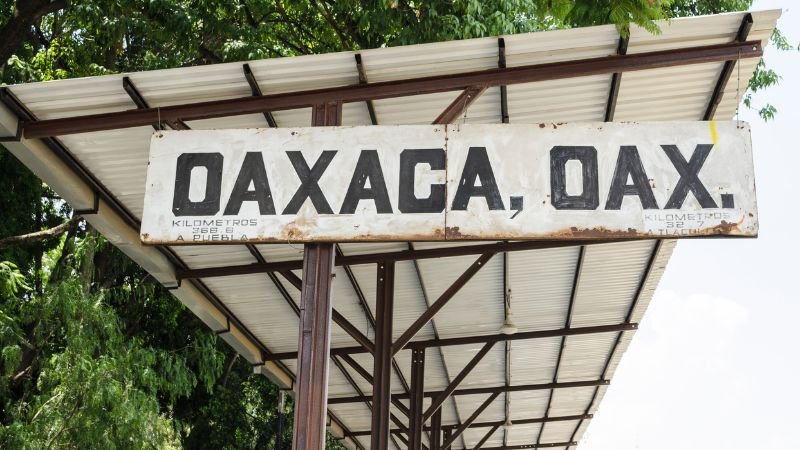
There are three syllables in the word “Oaxaca”. The accent is in the middle.
If we break them up, you get OA – XA – CA.
The first part is pronounced “WA“. The second bit is pronounced “HA“. And the last part is just “KA“.
So, putting it together, Oaxaca is pronounced WA – HA – KA. It should sound like this:
Simple, right? Absolutely!
Now that we have that out of the way, let’s take just a quick look at where Oaxaca is located in Mexico before we dive into why it is absolutely worth visiting.
Interesting Fact: the word “Oaxaca” is a derivation of the Nahuatl word huaxyacac, meaning “place of the guaje“, a name given to the Oaxaca valley by the Aztecs that referred to the seed pods of a type of tree growing in the area. After the Spanish arrival in 1519, the word huaxyacac was spelled using Spanish letters, eventually becoming “Oaxaca” as it is today.
Is Oaxaca Worth Visiting?
Where Is Oaxaca?
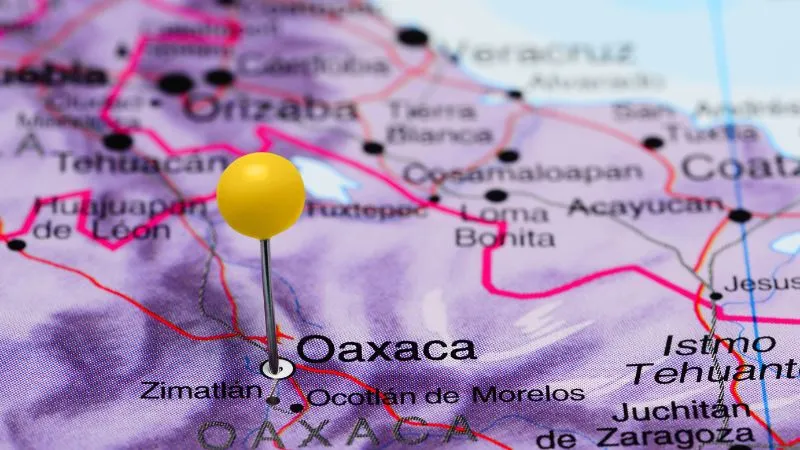
Oaxaca is a state of southern Mexico, with a southern borden on the Pacific Ocean. It neighbors the state of Chiapas to the east, the states of Puebla and Veracruz to the north, and the state of Guerrero to the west.
The state of Oaxaca is also home to the city of Oaxaca de Juárez, which is also known as Oaxaca City and rather confusingly simply as Oaxaca. References to Oaxaca can therefore be to either the city or the state, although usually you can quickly tell from the context what the speaker means.
Oaxaca City is the capital city of Oaxaca state and its cultural center. It is geographically situated in the Oaxaca Valley surrounded by lush mountains and verdant landscapes.
Its historic center is a UNESCO World Heritage Site and is adorned with beautiful cobblestone streets, colonial architecture, and vibrant markets.
Nearby to Oaxaca de Juárez are a number of true wonders of the world, including Hierve El Agua and the Tule Tree.
The region is also responsible for a diverse range of absolutely amazing products such as mezcal, pottery, chocolate, mole, alebrijes, and much more.
In fact, Oaxaca is so full of things to do, see and eat or drink that you will struggle to get it all done in a short trip!
Let’s get into the detail now so that we can answer the question: is Oaxaca worth visiting?
Is Oaxaca Worth Visiting?
Is Oaxaca Worth Visiting? 15 Reasons Why The Answer Is Yes!
So, is Oaxaca worth visiting?
Absolutely, and we’ve set out below a list of 15 reasons why.
Is Oaxaca Worth Visiting?
1: Cultural Diversity
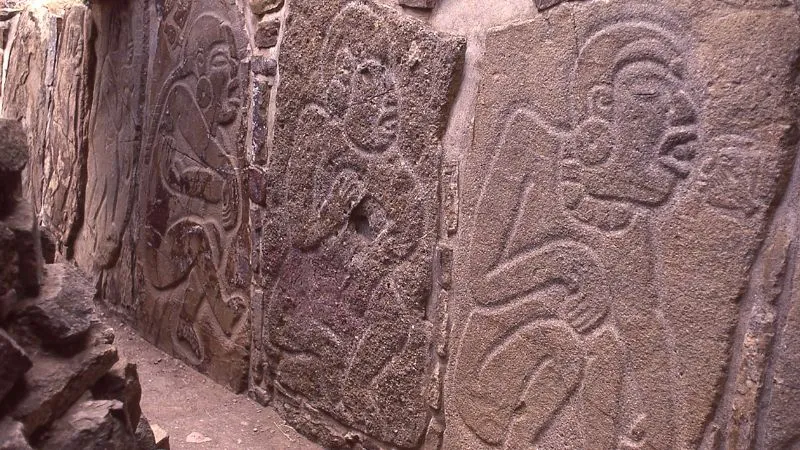
Oaxaca is home to 16 distinct indigenous groups, each contributing to the region’s vibrant cultural tapestry. The Zapotec community is the largest indigenous population in Oaxaca, followed by the Mixteco community.
The imprint of these indigenous cultures is everywhere in Oaxaca including in impressive archaeological sites such as Monte Albán and Mitla.
The Zapotec community resides in large part within the central valleys region of Oaxaca, which includes Oaxaca de Juárez.
The Mixteco communities reside primarily in the Mixteca region of Oaxaca, which lies to the west of the central valleys region.
Most of the indigenous groups are large enough to have retained their language and to have continued their traditions.
Much of this is expressed in the Oaxaca region in varied art forms, agricultural practices, and artisanal skills, making it absolutely worth exploring when you visit Oaxaca.
Is Oaxaca Worth Visiting?
2: Archaeological Sites
People have been living in and around Oaxaca for thousands of years. The extensive tale of humanity is told in Oaxaca’s architecture and the many archaeological ruins that can be found close to Oaxaca City.
Monte Albán

One of the most iconic archaeological sites is Monte Albán, a UNESCO World Heritage site just three miles from Oaxaca.
Built by the Zapotec civilization around 500 BC, Monte Albán’s towering pyramids, grand plazas, and intricate hieroglyphs provide a glimpse into a sophisticated society that thrived centuries ago. It was abandoned around 750 AD.
It is extensive and remarkably well-preserved, and you can happily spend several hours exploring.
Provided that you’re not afraid of a little heat, it’s worth visiting Oaxaca to see Monte Albán if you have an interest in history and like visiting historical ruins.
Is Oaxaca Worth Visiting?
Mitla
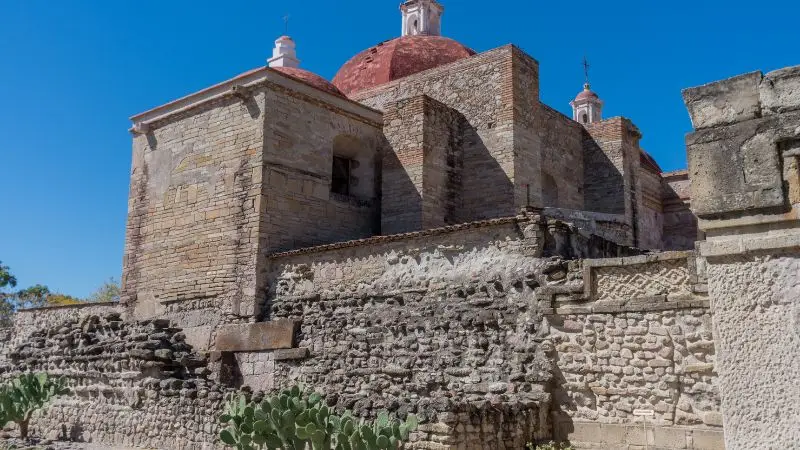
The Zona Arqueológica de Mitla, known as Mitla, lies approximately 28 miles to the south-east of Oaxaca.
The site preserves the remarkable remains of an ancient Zapotec city, and is thought to have been inhabited as far back as about 500 BC.
The ruins are situated in a valley nearly a mile above sea level and are split into several groups of structures.
These include a ancient room with enormous supporting columns, elaborate tombs, and a newer church built by the Spanish colonists.
Shortly after their arrival in Oaxaca, the Spanish destroyed much of the city to remove its religious power, and used the stone to build a church on the Mitla site, known as the Church of San Pablo.
Mitla is known for its intricate stone mosaics, which are sometimes called “Zapotec Greco”. It also has a number of ancient friezes adorning walls and floors.
Is Oaxaca Worth Visiting?
3: Iconic festivals
Oaxaca is also the venue of some of the most iconic festivals in Mexico, if not the world.
These unforgettable events give you a great taste of Oaxaca’s vibrant culture.
Day of the Dead (Día de los Muertos)

The most iconic of these is the Day of the Dead (Día de los Muertos) festival. The Day of the Dead is one of the most recognizable festivals on Earth and is held from 31 October to November 2nd each year.
There are other places where you can see the Day of the Dead festivities, notably Mexico City. However, although Mexico City Day of the Dead is spectacular in its own right, it is worth seeing in Oaxaca as it is celebrated there in a more meaningful way.
The Day of the Dead in Oaxaca is about families coming together to honor their ancestors. They do this by creating elaborate altars adorned with marigolds, candles, and offerings that are used to persuade their loved ones to return to the land of the living for a short time.
Although death is a key feature of the festival, the celebrations are not macabre. On the contrary, local cemeteries come alive with music and festivities as locals remember the dead with a blend of indigenous beliefs and Catholic traditions.
Outside the cemeteries, locals and tourists will often don striking costumes and intricate face paint and participate in colorful parades that make their way through the city streets.
Day of the Dead in Oaxaca is 100% a must-see and one big reason why it is worth visiting Oaxaca.
Is Oaxaca Worth Visiting?
La Guelaguetza
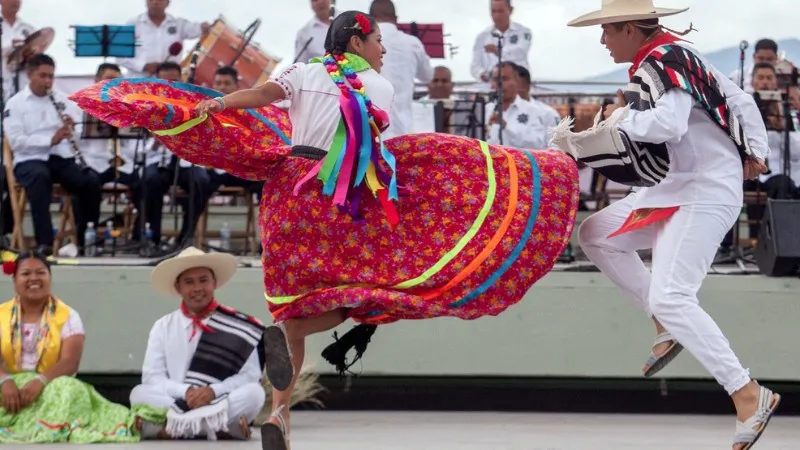
La Guelaguetza is a flamboyant festival that celebrates Oaxaca’s indigenous cultures through vibrant music, dance, and traditional clothing.
It is held annually in late July each year in an enormous open-air amphitheater called the Auditorio Guelaguetza, which is located on Cerro del Fortín (Fortín Hill) in Oaxaca.
The unique location where it takes place every year has resulted in La Guelaguetza also being known as Los Lunes del Cerro (Mondays on the Hill).
The word Guelaguetza means “offering” in Zapotec, reflecting the spirit of sharing and unity among different ethnic groups.
While not as internationally popular as Día de los Muertos, La Guelaguetza is very popular with local Oaxacans and is definitely worth going to Oaxaca to see.
Tip: if you’re keen to see La Guelaguetza, make sure that you get tickets to the auditorium ahead of your trip, as the festival is very popular and may sell out if you’re not quick!
Is Oaxaca Worth Visiting?
Noche de Rábanos (Night of the Radishes)

Noche de Rábanos, or Night of the Radishes, is a captivating annual tradition in Oaxaca that takes place on 23 December in each year.
It is held in the Zócalo, the main square of Oaxaca City adjacent the Cathedral of Our Lady of the Assumption.
The Zócalo becomes a hub of activity during this event, showcasing the artistic prowess of local artisans who transform humble radishes into intricate sculptures depicting religious scenes, folklore, and imaginative creations.
Beautiful lights line the square and attract both locals and tourists who come to admire the unique and creative artworks.
This is a great festival for families, as it intertwines Oaxaca’s rich culture, creativity, and holiday spirit, capturing the essence of community and tradition.
Is Oaxaca Worth Visiting?
4: Textiles And Crafts
Oaxaca’s artistic landscape is a treasure trove of craft traditions that have thrived for generations, captivating visitors with their intricate beauty and cultural significance.
Many of the satellite towns around Oaxaca have specialised over the years in the production of a particular product using traditional methods.
We’ve highlighted just a few of these below to give you an idea of why it is worth visiting Oaxaca to see them.
Oaxacan Pottery
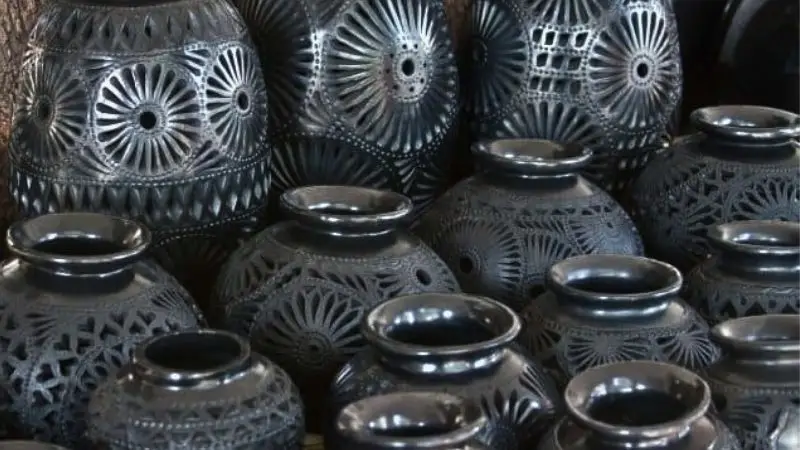
The town of San Bartolo Coyotepec is about 10 miles south of Oaxaca City and is synonymous with “barro negro” pottery.
Barro Negro is a beautiful form of pottery produced using artisanal techniques and is characterized by its glossy black finish.
The production process is traditional, often passed on within artisan families.
Skilled artisans first shape, mold, and carve each piece in an intricate process that demands patience and precision.
Once this process is complete, the clay is carefully fired in a process that gives rise to the signature glossy black finish of barro negro.
The meticulous craftsmanship of barro negro and its connection Oaxaca’s traditional methods of production make it an emblem of Oaxaca’s indigenous heritage and artisanal excellence.
Is Oaxaca Worth Visiting?
Alebrijes
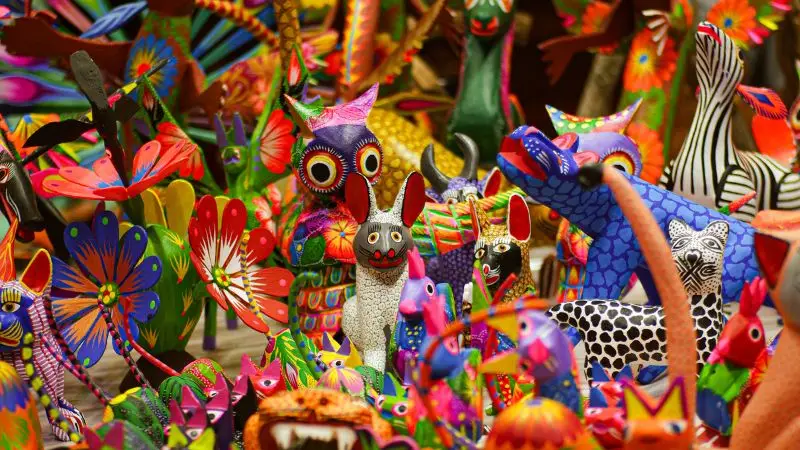
The town of San Martín Tilcajete, situated about 18 miles south of Oaxaca, is famous for its vividly colored and intricately carved wooden creatures known as alebrijes.
Alebrijes were originally created in Mexico City by Pedro Linares López in 1936 using papier-mâché. In modern times, they have become quite famous and were most recently featured in the Pixar film Coco.
Alebrijes have a strange back-story. Legend has it that López fell into a feverish state and dreamed of fantastic creatures that screamed “Alebrijes! Alebrijes! Alebrijes!” over and over. When he awoke, he began to create the creatures he observed using his skills in papier-mâché.
As they grew in popularity, artisans in Oaxaca also began to produce alebrijes. However, rather than use papier-mâché, the Oaxacan artisans produce their alebrijes using carved copal wood.
The process of producing alebrijes is quite intricate, and requires several steps. Once the copal wood has been selected and the carving completed, the alebrije must be sanded for hours until it is completely smooth.
After the sanding process is completed and the wood dust has been cleaned away, the alebrije is then meticulously painted using bright colours.
Traditionally, these various tasks were divided up amongst the artisan family. Typically, the men would carve, the children would sand, and then the women would paint.
Today, as a result of the immense popularity now enjoyed by alebrijes, many families have expanded their production process into large workshops. Touring these workshops to see the artisans at work is a great reason that it is worth visiting Oaxaca.
Is Oaxaca Worth Visiting?
Woven Rugs

The looms of Teotitlán del Valle, around 18 miles to the west of Oaxaca, are famous for the production of beautiful and intricately woven rugs.
The production process of Oaxaca rugs begins with the careful selection of materials.
First, locally sourced wool is meticulously cleaned, spun, and dyed using natural pigments derived from plants, insects, and minerals.
Artisans then set up their looms, threading each strand with precision and care. The intricate designs are often inspired by Zapotec symbols and geometric patterns that hold deep cultural meanings.
The weaving process is carried out using traditional pedal looms that require both skill and rhythm as the weaver navigates the complex pattern, row by row. The meticulousness of the process ensures that each rug is not just a piece of décor but a work of art that encapsulates generations of wisdom and creativity.
The final step involves the finishing touches of careful trimming, washing, and pressing. The result is a masterpiece that brings the heart of Oaxaca into homes around the world.
Is Oaxaca Worth Visiting?
5: Culinary Excellence
Oaxaca is known as the culinary heart of Mexico.
Foodies will fall in love with the extraordinary diversity of delicious and unique foods available.
We’ve set out below just a small sample of must-try Oaxacan foods.
Is Oaxaca Worth Visiting?
Oaxacan Mole

Oaxaca is the birthplace of mole, a rich, complex sauce that combines chiles, spices, and chocolate into a unique mix of flavors.
Mole can be used for both meat and vegetarian dishes, and different types of mole that can be used for different food and drink pairings.
Of the over 500 types of mole, there are seven main types, of which mole negro is the most well-known.
From the deep and smoky mole negro to the vibrant and earthy mole coloradito, experiencing the diverse range of moles is a culinary adventure in itself.
Is Oaxaca Worth Visiting?
Oaxacan Street Food

One of the most enjoyable types of food to try in Oaxaca is the fantastic street food. Colorful markets and bustling street corners brim with mouthwatering options.
A local favourite is tlayudas, which are oversized tortillas topped with beans, cheese, and various toppings. Another Oaxacan staple is tamales, which is a traditional form of savory or sweet corn dough steamed in banana leaves.
You can also try memelas, quesadillas, empanadas and many more different types of street food, and you can wash it down with refreshing tejate or hot chocolate.
Street food vendors are culinary artists, crafting affordable, delectable creations that offer an authentic taste of Oaxaca’s cultural richness, leaving a lasting impression on every eager palate.
Is Oaxaca Worth Visiting?
Oaxacan Chocolate
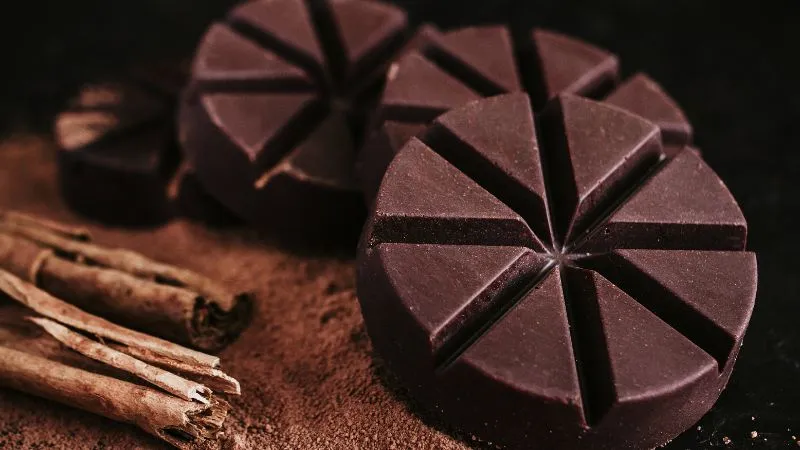
Oaxaca is also home to a delicious form of chocolate which is produced locally in Oaxaca.
Like many products produced in Oaxaca, Oaxacan chocolate is produced using cacao grown locally in either Oaxaca or nearby Chiapas, and then refined using traditional methods.
After drying and roasting the cacao beans, a metate or large grinding stone is used to grind down the beans into a powdered form.
The powdered chocolate is then spiced with chilis and other spices and used in champarrado or tablet chocolate.
There are lots of great shops in Oaxaca such as Chocolate Guelaguetza, Mayerdomo and Hotel Chocolate where you can sample these amazing products or buy some souvenirs or gifts to bring home with you.
Is Oaxaca Worth Visiting?
6: Scenic Landscapes
Oaxaca’s cultural diversity is complemented by its remarkable geographical variation.
In Oaxaca, you can find towering mountains, fertile valleys and pristine coastlines. Each of these geographies nurture distinct cultures that have adapted to their surroundings.
Is Oaxaca Worth Visiting?
Mountain Ranges

The impressive Sierra Madre mountain ranges surrounding Oaxaca are excellent for hiking. There is an extensive network of hiking trails, ranging from easy strolls to challenging treks.
If you are interested in seeing how local Oaxacans live in the mountainous ares, you can also take an eco-tour of the Pueblos Mancomunados. These are a collective of eight indigenous Zapotec villages in the mountains about 35 miles north of Oaxaca.
The Pueblos Mancomunados have embraced sustainable tourism practices, making it an ideal destination for eco-conscious travellers.
The communities are committed to preserving their environment and culture, while offering visitors an opportunity to experience responsible tourism firsthand.
You can also mix the two and hike from village to village along the trails, or they can be reached by road if you prefer.
Is Oaxaca Worth Visiting?
Coastal Areas

Whereas exploring the mountains requires preparation, stamina and energy, Oaxaca’s 370-mile long coastline is rather more relaxed.
Coastal towns like Puerto Escondido, Huatulco and Mazunte operate on a different cultural rhythm, typical for a coastal lifestyle.
Oaxaca boasts a series of pristine beaches along the Pacific Ocean, offering visitors a chance to unwind in a tranquil and picturesque setting.
Playa Zicatela, often referred to as the “Mexican Pipeline,” attracts surfers from around the globe with its powerful waves and challenging breaks.
For those seeking a more laid-back beach experience, nearby beaches like Playa Carrizalillo and Playa Manzanillo offer calmer waters and a relaxing atmosphere.
The coastal regions are also hubs of biodiversity and ecological significance. Many areas provide crucial nesting grounds for sea turtles, and conservation efforts are in place to protect these endangered species.
In fact, the town of Mazunte is home to the National Mexican Turtle Center, where visitors can learn about turtle conservation efforts and even witness the release of baby turtles into the ocean.
Whether it’s surfing, exploring eco-friendly beach towns, or discovering secluded coves, Oaxaca Pacific coastline offers a perfect opportunity to unwind.
Is Oaxaca Worth Visiting?
Valley Regions
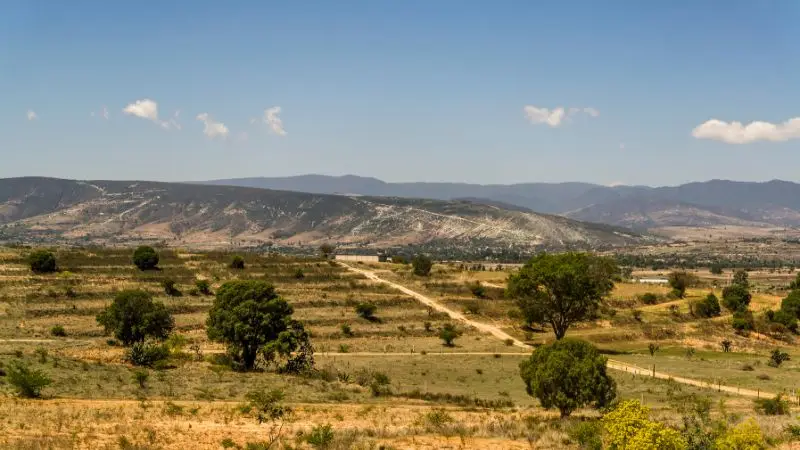
The Oaxaca valley region spans approximately 2,500 square miles and is flanked by the Sierra Madre del Sur and Sierra Norte mountain ranges.
The landscape features a diverse range of ecosystems, from fertile valleys and rolling hills to rugged mountain terrain.
Central to the region is Oaxaca City, surrounded by agricultural fields that yield crops such as corn, beans, and agave.
The valley’s altitude varies, resulting in distinct microclimates that support various plant species and wildlife.
The valley’s topography allows for a variety of outdoor activities, including hiking, birdwatching, and exploring archaeological sites like Monte Albán and Mitla.
The diversity and breadth of the Oaxaca valley regions means that there is something for everyone and definitely worth a visit.
Is Oaxaca Worth Visiting?
7: Friendly People

Oaxaca is known for its friendly people and general welcoming atmosphere, which creates a memorable experience that goes beyond its stunning landscapes and cultural treasures.
The friendliness of Oaxaqueños is noticeable when talking to local artisans about their amazing creations or with a street vendor when buying a tlayuda.
Part of this likely comes from the conservative lifestyle practised by Oaxacans, which is a blend of traditional indigenous practices and the region’s catholic roots following the arrival of the Spanish.
Family and community are simply held in very high regard, which leads to Oaxacans offering guests top-notch hospitality.
The friendliness of the people definitely makes for a more enjoyable trip and is a great reason why Oaxaca is worth visiting.
Is Oaxaca Worth Visiting?
8: Oaxaca’s Colonial Architecture
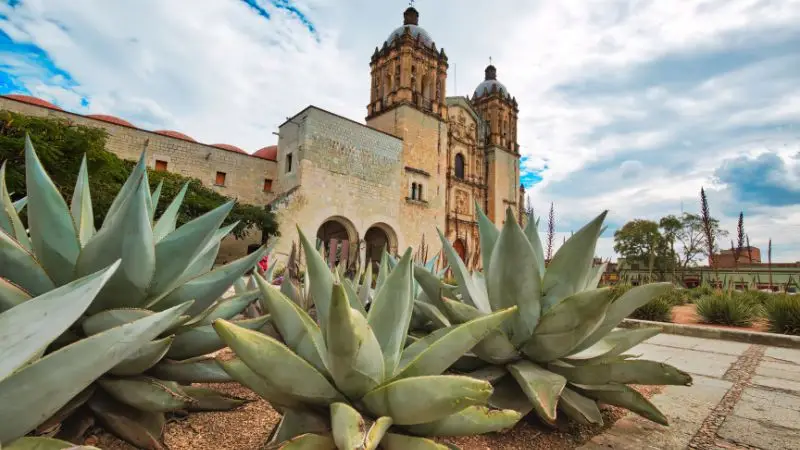
The Oaxaca region’s history extends to the Aztecs and the Spanish conquest. Oaxaca’s colonial heart, the city of Oaxaca de Juárez, is a living testament to Spanish cultural influence.
The city’s cobblestone streets are adorned with grand churches, ornate facades, and tranquil courtyards that harken back to its Spanish colonial era.
The Cathedral of Oaxaca, a stunning example of Baroque architecture, and the Santo Domingo Church with its intricate carvings are iconic landmarks.
As you explore Oaxaca’s colonial architecture you’ll get a sense of the region’s layered history and the interplay of indigenous and European influences.
Your hotel is probably a great place to start your explorations. Some hotels, such as Quinta Real Oaxaca, are housed in colonial-era buildings that are just bursting with history.
If you enjoy love admiring period architecture, you will have plenty to see in Oaxaca and it is definitely worth visiting.
Is Oaxaca Worth Visiting?
9: Natural Wonders
Oaxaca’s allure extends beyond its immediate borders, offering travelers the unique opportunity to explore rare and captivating sites that are just a stone’s throw away.
Hierve El Agua

One such site is Hierve el Agua, a natural wonder located about an hour east of Oaxaca.
Hierve el Agua is a geological marvel comprised of petrified waterfalls and a series of mineral-laden pools formed over thousands of years.
The stunning contrast between the white mineral deposits and the surrounding lush mountains creates a breathtaking panorama that seems to defy nature itself.
Hierve El Agua is a fantastic day trip, which you can easily combine with a mezcal distillery tour or a visit to the Tule Tree by booking a tour.
Is Oaxaca Worth Visiting?
Tule Tree
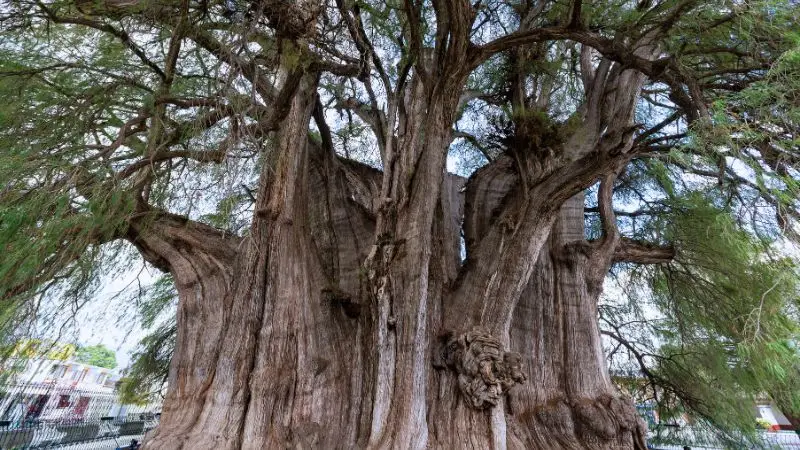
Venturing a bit farther, the town of Santa María del Tule boasts an awe-inspiring Montezuma cypress, known as el Árbol del Tule.
This colossal tree has a girth of over 130 feet and is estimated to be more than 2,000 years old.
Its sheer size and historical significance make it a symbol of Oaxaca’s deep-rooted connection to the land.
The proximity of these rare sites to Oaxaca’s vibrant city hub makes the region an exceptional destination for travelers and definitely worth a visit.
Is Oaxaca Worth Visiting?
10: Mezcal Culture
You may already be thinking that Oaxaca has an incredible range of culinary notches on its belt, and you’d be right.
However, if you like your agave spirits, you will likely consider that Oaxacan mezcal is its crowning achievement.
Is Oaxaca Worth Visiting?
Mezcal

Oaxacan is the birthplace of mezcal. It has a deep history in Oaxaca, having been part of its culture and traditions for hundreds of years.
Mezcal is extremely diverse. Unlike tequila, which is produced from the agave tequilana grown primarily in Jalisco, mezcal can be created using a variety of different agave forms.
In recent years, Oaxacan mezcal has become globally famous. Many entrepreneurs have partnered with local producers to distribute previously little-known mezcal varieties.
Interesting Fact: like tequila, mezcal can also be aged in oak barrels. Unaged mezcal is known as joven or young. Reposado, or rested mezcal is aged from 4 to 12 months. Anejo or aged mezcal is aged for at least 12 months.
Is Oaxaca Worth Visiting?
Mezcal Distilleries
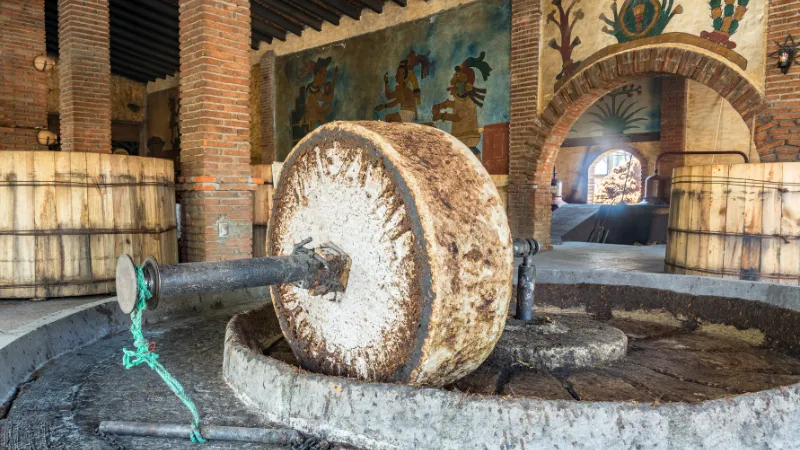
Like other artisans in the Oaxaca region, mezcal production is often a family business spanning generations.
Despite the increased popularity of mezcal in recent years, traditional production methods continue to be used.
It it not unusual to find a mezcal distillery where a molino, a heavy stone wheel, is pulled by a donkey and used to crush the roasted agave crowns.
The traditional production process is important for a few reasons. It limits the supply of mezcal, ensuring that it remains valuable. It also ensures that the quality remains high, as each harvest is carefully refined using hand tools and simple refining tools.
Is Oaxaca Worth Visiting?
Mezcal Tastings and Tours

When you are in Oaxaca, one of the best things to do is to visit one of the many mezcal distilleries or mezcalerias.
There are countless mezcalerias in Oaxaca de Juárez where you can book a mezcal tasting. Tastings are carried out by experienced and knowledgeable bartenders who will happily spend a few hours with you explaining the production process and different flavours of mezcal varieties.
You can also visit a mezcaleria and see how the production process works firsthand. Unless you have direct contacts, this is probably best done using a tour guide, as they will have pre-arranged times to ensure that the mezcaleros will be available to show you around.
If you’re interested in doing a tour, read our related articles on the best mezcal tours in Oaxaca and best places to try mezcal in Oaxaca.
Is Oaxaca Worth Visiting?
11: Oaxaca Beaches
With its extensive pacific coastline stretching for 370 miles, Oaxaca also has a range of stunning beaches for you to explore.
Beyond being breathtakingly beautiful, Oaxaca’s beaches are also quite diverse, and you will be able to find one that suits your purposes best.
Is Oaxaca Worth Visiting?
Puerto Escondido

For surfers, Puerto Escondido is known for having amazing waves, and Playa Zicatela in particular is famous for its massive swells.
For those of you keen to get in the water but would prefer to do some underwater exploring, many beaches are teeming with colorful fish, coral reefs, and even the opportunity to spot sea turtles.
Is Oaxaca Worth Visiting?
Mazunte
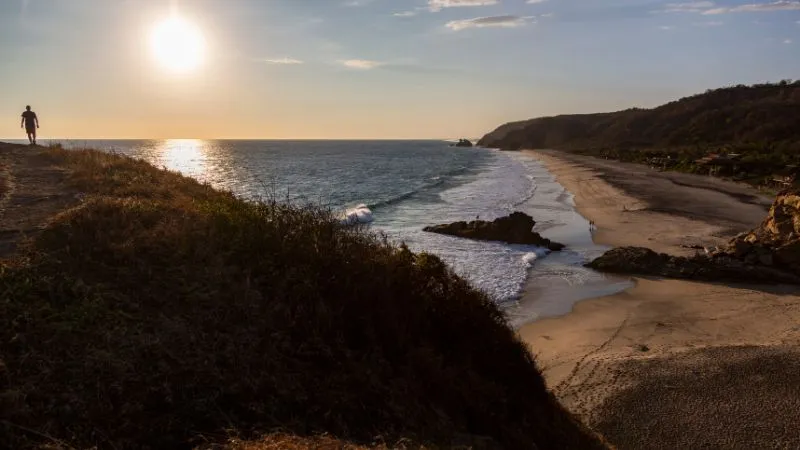
Outside of the water, beach towns like Mazunte have gorgeous beachside resorts that offer a bohemian vibe, with beachfront huts, yoga retreats, and vibrant nightlife that cater to both relaxation and adventure.
The influx of tourists over recent years has seen an expansion in the culinary offering of many establishments.
You can still enjoy fresh seafood in beachside seafood shacks, but you also now have the option of dining in upscale oceanfront restaurants.
Is Oaxaca Worth Visiting?
Huatulco

During certain times of the year, Oaxaca’s coastline also becomes a prime spot for whale watching. If you haven’t seen whales breach and play in their natural habitat before, it is an unforgettable experience.
Finally, if you’re planning a romantic getaway, Oaxaca’s beaches offer some of the most breathtaking sunsets you will find.
Oaxaca’s beaches are definitely a reason that makes visiting Oaxaca worth doing.
Is Oaxaca Worth Visiting?
12: Lively Markets
Oaxaca has lots of bustling markets where you can buy fruits, vegetables, chocolate, spices, alebrijes, and other products produced locally in Oaxaca.
They’re a great place to indulge in the region’s culinary and artisanal delights while getting a glimpse of the vibrant local lifestyle.
The most well-known three markets are Mercado Benito Juárez, Mercado de Artesanias and Mercado 20 de Noviembre. We’ve described each of these below.
Is Oaxaca Worth Visiting?
Mercado Benito Juárez
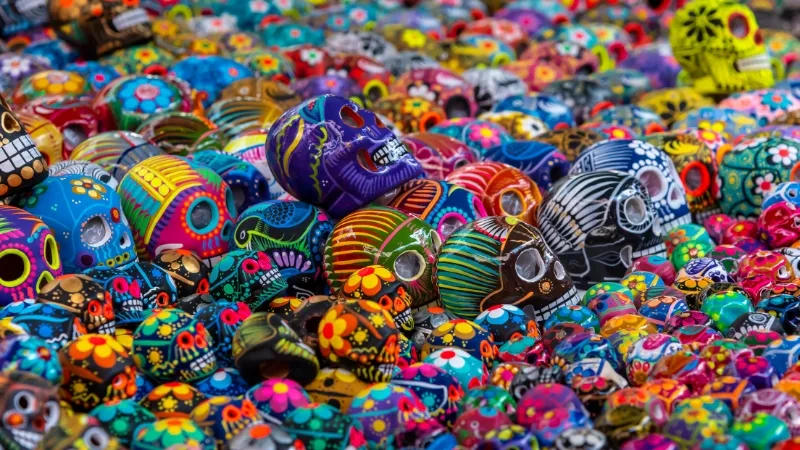
The Mercado Benito Juárez is very centrally located in the historic centre of Oaxaca, one block south-west of the Zócalo.
It’s a mixed market, selling clothing and artisanal products of all kinds, a wide variety of foodstuffs, and, well, basically everything that you could think of.
The market is a covered market, and despite the hustle and bustle, it is generally quite well-organised. Vendors of similar products are usually grouped together, which makes it easier to shop.
Is Oaxaca Worth Visiting?
Mercado de Artesanias

The Mercado de Artesanías is a small handcraft market in the historic centre of Oaxaca, a few blocks to the south of the Zócalo.
The market has a wealth of handcrafted fabrics, weavings, leather goods, clothing, basketry, pottery, wood carvings, and other artwork.
The vendors are artisans themselves, or vendors of products produced locally in Oaxaca.
The market is a great place to shop if you are looking to find a gift, or if you are looking to looking to buy quality Oaxacan goods. The prices tend to be lower than those sold at retail shops elsewhere in the city.
Is Oaxaca Worth Visiting?
Mercado 20 de Noviembre
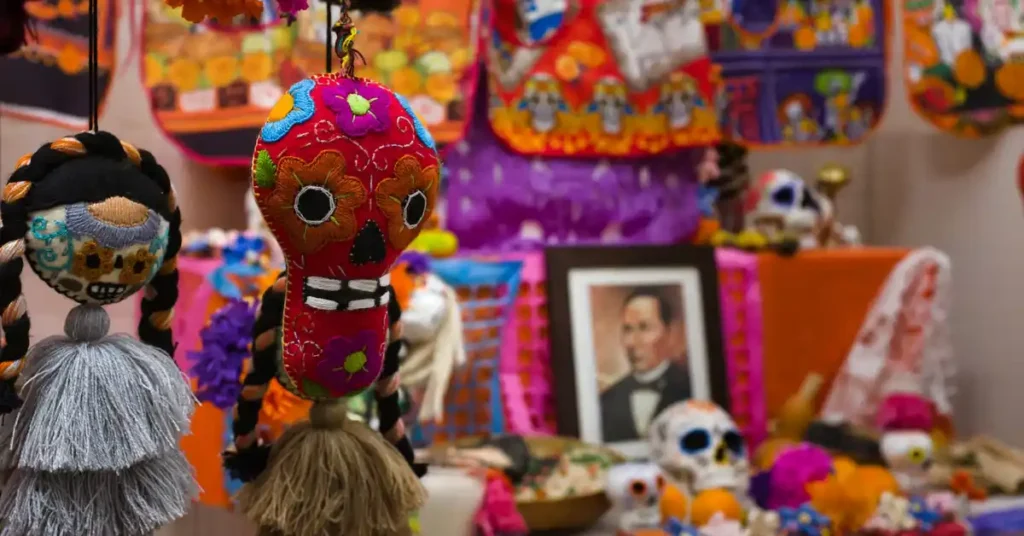
The Mercado de 20 Noviembre is a market in the historic centre of Oaxaca, three blocks to the south of the Zócalo.
The market specializes in food and drinks, although there are some stalls also selling artisanal products. It also has a reputation for offering visitors a huge variety of food and drink samples.
A must-see is the famous Pasillo de Humo, which takes its name from the light haze of smoke created from various stalls grilling fresh meat.
Ordering the meat, choosing your condiments and vegetables, and then trying to eat the mountain of food that is brought to you is a fantastic experience.
Is Oaxaca Worth Visiting?
13: Great Museums
If you are interested in Oaxaca’s history and culture, you can learn all about it in its museums, including the Museo de las Culturas de Oaxaca.
Is Oaxaca Worth Visiting?
Museo de Culturas de Oaxaca
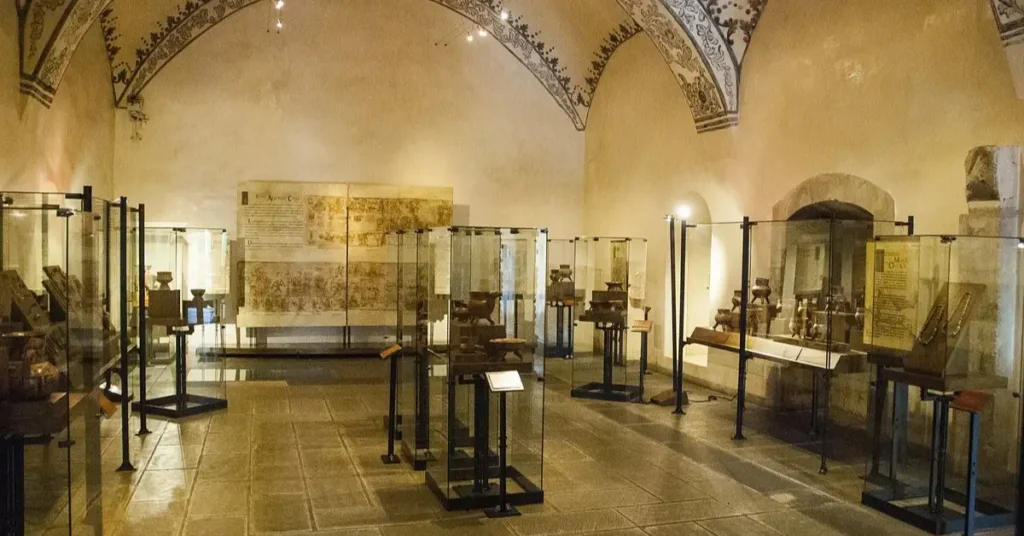
The Museo de Culturas de Oaxaca is a beautiful building in the historic centre of Oaxaca. The building was originally built in 1831 as a Dominican friary, and was later used as a military barracks.
The museum has a library with an extensive collection of very rare books and manuscripts and historic objects from Zapotec and Mixtec cultures.
If you aren’t going to make it to the Zona Arqueológica de Monte Albán, there are jewelled tombs from the site exhibited at the museum that you should check out.
Is Oaxaca Worth Visiting?
Museo Textil de Oaxaca
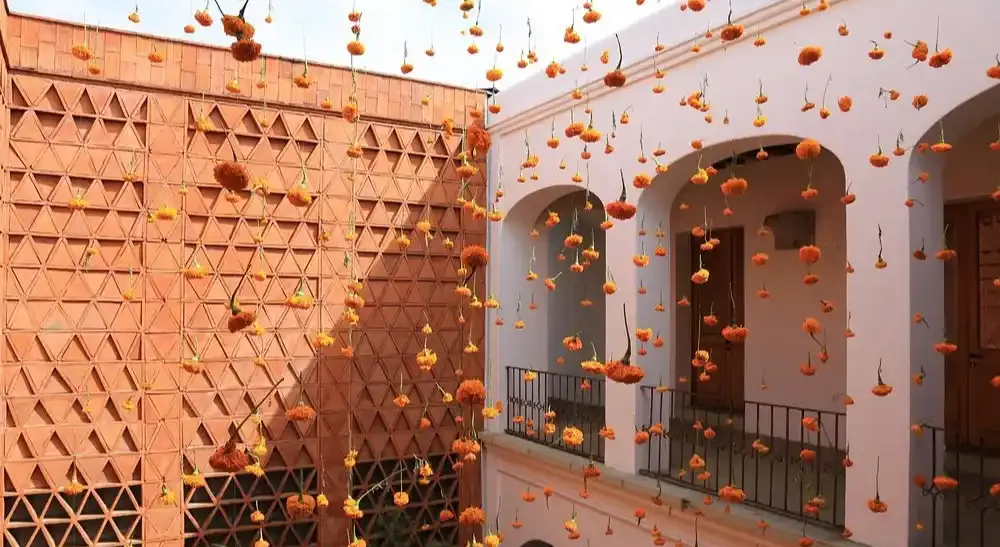
El Museo Textil de Oaxaca is a small museum situated in the historic centre of Oaxaca.
The museum building dates to the 19th century, during which time it was used a hospital, the Hospital de Bélen. It was later bought and restored by a Oaxacan charity, and now houses the Museo Textil de Oaxaca.
The museum showcases some of the many varieties of embroidered and woven goods for which Oaxaca is so well-known. It has over 7,000 pieces in its extensive and very rare collection.
Some of the designs were traditionally used by the Zapotec, Nahua and Mixtec cultures. Many of these are recognisable in products made by local Oaxacan textile producers today.
Is Oaxaca Worth Visiting?
Jardín Etnobotánico de Oaxaca
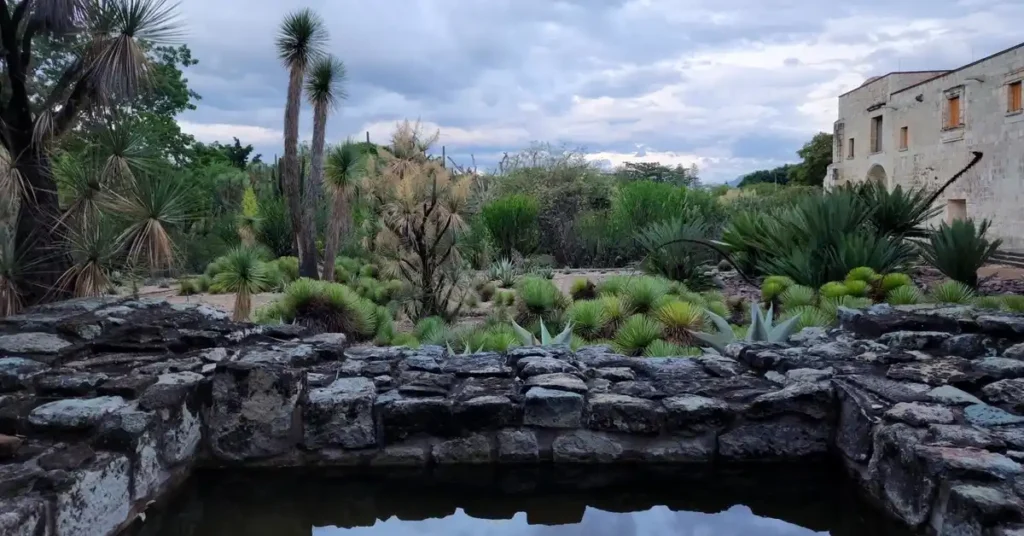
The Ethnobotanical Garden of Oaxaca (El Jardín Etnobotánico de Oaxaca) is a botanic garden featuring over 1,300 plants native to the Oaxaca region.
To protect the plants, and also the visitors, tours are led by garden personnel.
Tours are operated in Spanish, English, French and German. The English tour runs for two hours, and the others are one-hour tours.
Is Oaxaca Worth Visiting?
14: Authentic Oaxacan Cooking Classes
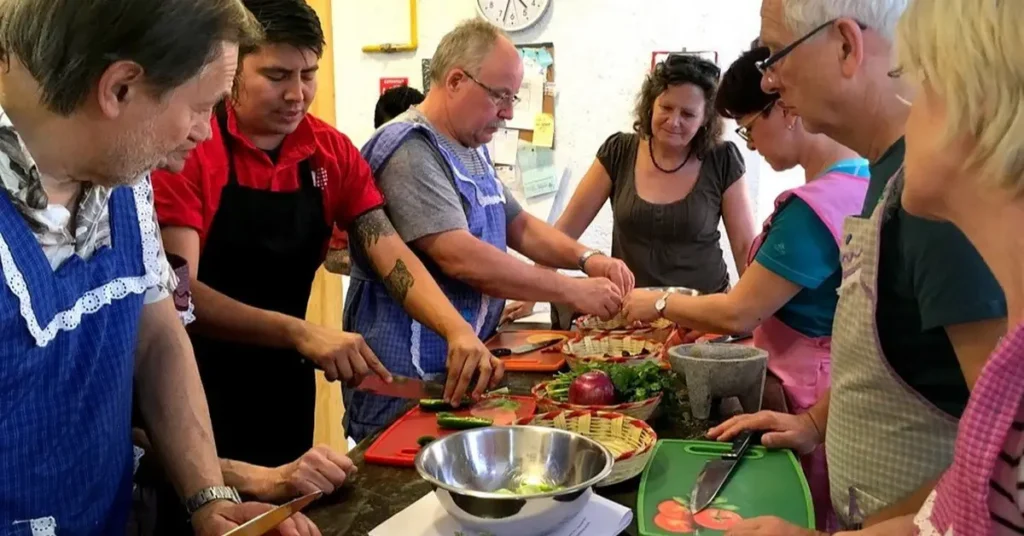
If you love Mexican food (and of course you do!), you can take a cooking class and learn from local Oaxacans.
Learning to cook an amazing meal is a great gift for yourself or your loved one. You get to learn a fun skill that you take with you and keep forever.
Some hotels, such as the Hotel con Corazón, offer cooking classes to guests onsite. However, any hotel will be able to refer you to the best places to do a cooking class in Oaxaca where you could learn to cook some of the seven moles, tlayudas, or memelas.
This is one where is probably more fun to do as a group or through a tour guide. Tours will usually take you to a local market to buy the ingredients once you decide what to cook, which is an experience in and of itself.
Is Oaxaca Worth Visiting?
15: Art Galleries and Studios

If you are interested in art, Oaxaca has lots of art galleries and studios showing contemporary works and traditional craftsmanship.
Art galleries in Oaxaca City display many different forms of artwork, ranging from indigenous-inspired pieces to modern interpretations.
The studios offer a more intimate boutique approach and let you get to know the artist on a personal level.
We’ve set out a few examples of these below.
Is Oaxaca Worth Visiting?
Oaxaca Contemporary Art Museum (Museo de Arte Contemporáneo de Oaxaca)
The Oaxaca Contemporary Art Museum is a significant cultural institution, showcasing a diverse collection of contemporary artworks.
It was founded in 1992 and features both local and international artists, offering insights into the dynamic conversations shaping modern art.
Through its exhibitions, Oaxaca Contemporary Art Museum invites visitors to explore a wide range of mediums, from painting and sculpture to multimedia installations.
The museum’s dedication to fostering artistic dialogue and pushing creative boundaries makes it an essential destination for those seeking to engage with Oaxaca’s evolving artistic landscape.
Is Oaxaca Worth Visiting?
Centro Fotográfico Manuel Álvarez Bravo (Manuel Álvarez Bravo Photography Center)
The Manuel Álvarez Bravo Photography Center honors the legacy of renowned photographer Manuel Álvarez Bravo.
The center was established in 1991 and houses a comprehensive collection of his iconic works, spanning decades of his prolific career.
With a focus on black-and-white photography, the center provides a window into Oaxaca’s past, capturing historical moments, cultural nuances, and social dynamics.
Through exhibitions and educational programs, the center not only commemorates Álvarez Bravo’s contributions but also serves as a vital resource for those interested in exploring the visual history of Oaxaca and beyond.
Is Oaxaca Worth Visiting?
La Curtiduría
“La Curtiduría” goes beyond the conventional gallery setting, serving as an active art center.
Through a range of workshops, exhibitions, and residencies, it offers visitors an immersive experience in Oaxaca’s artistic landscape.
The center was established in 1996 and has been a hub for contemporary art, encouraging artists and enthusiasts to engage in hands-on exploration.
With a focus on collaborative learning and experimentation, “La Curtiduría” provides a platform for creative minds to converge, exchange ideas, and contribute to Oaxaca’s ever-evolving artistic narrative.
Is Oaxaca Worth Visiting?
When is the Best Time to Visit Oaxaca?

Oaxaca has a subtropical high-altitude climate, meaning that it typically has warms day and then cools off in the evenings.
There is also a dry season and a rainy season, with the rainy season lasting from June through to September.
The best time to visit Oaxaca therefore depends a little or your personal preference, but in my opinion, late October is the best time to visit Oaxaca. You’ll get to see the Día de los Muertos festival, the days are warm, the nights are cool, and the city is lively.
The downside, though, is that prices are expensive and the city is full of tourists doing exactly the same thing as you!
If you’re interested in finding out more about your options here, check our related article on the best time to visit Oaxaca.
Is Oaxaca Worth Visiting?
How Do I Get To Oaxaca, Mexico?
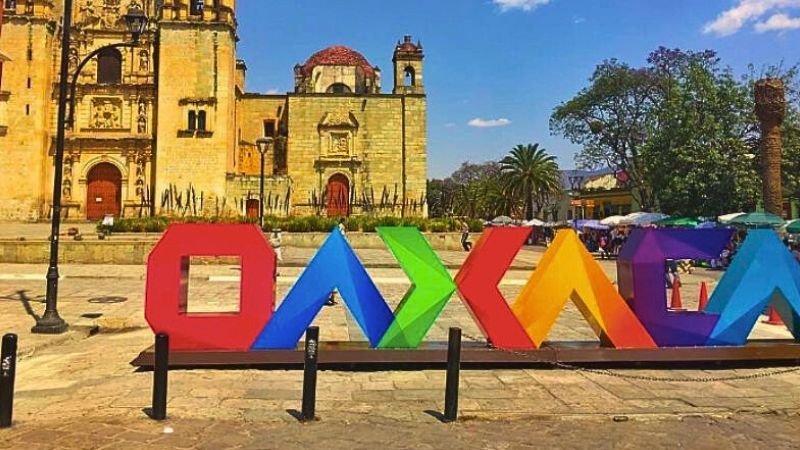
Now that you know what airport is closest to Oaxaca, let’s look at the best way to get there.
The airport is currently served by six airlines: Aeroméxico, American Airlines, TAG Airlines, United Airlines, VivaAerobus and Volaris.
From the United States, you can get direct flights from Dallas Forth Worth, Houston and Los Angeles. These flights aren’t all that frequent, though, so you’ll need to check which days flights are offered if you are planning on flying direct from these cities.
From with Mexico, you can get a connecting flight from any of Cancun, Guadalajara, Mérida, Mexico City, Mexico City Santa Lucia, Monterrey or Tijuana. The Mexico City to Oaxaca connection is by far the busiest route, followed by the connection from Tijuana.
You can also get a direct flight to Oaxaca from Guatemala City.
Direct flights are obviously preferable if possible, as they reduce your layover time in your connecting airport hub.
You can check prices and availability at Booking.com, Tripadvisor or Expedia.
Is Oaxaca Worth Visiting?
Is Oaxaca Worth Visiting: FAQs
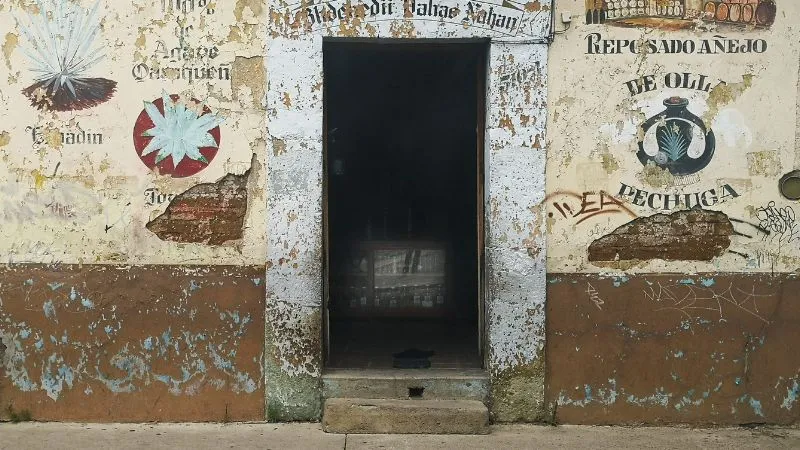
Hopefully we’ve been able to answer the important question of “Is Oaxaca Worth Visiting?”, as well as most of your other questions.
If not, take a look at our list of frequently asked questions below to see if you can find your answer there!
Is Oaxaca Worth Visiting?
What is So Great About Oaxaca?
Oaxaca’s greatness lies in its harmonious blend of rich cultures, diverse landscapes, and captivating traditions.
From archaeological wonders to vibrant markets, artisanal crafts to culinary masterpieces, Oaxaca offers an immersive experience that celebrates heritage and fosters a deep connection with nature and humanity’s creative spirit.
Is Oaxaca Worth Visiting?
Is Oaxaca A Walkable City?
Yes, Oaxaca is a wonderfully walkable city. Its historic center is compact and pedestrian-friendly, allowing visitors to explore its cobblestone streets, colonial architecture, markets, and cultural sites on foot.
The city’s charm is best appreciated through leisurely strolls that reveal its vibrant street life, art, and local flavors.
Is Oaxaca Worth Visiting?
How Many Days Should I Spend In Oaxaca?
Spending at least 4-5 days in Oaxaca allows a fulfilling experience.
That will allow you to explore the city’s markets, museums, and historic sites, venture into the surrounding valleys for cultural encounters and natural beauty, savor diverse cuisine, and immerse yourself in the festivals, arts, and traditions that make Oaxaca truly exceptional.
Is Oaxaca Worth Visiting?
What Is The Best Month To Visit Oaxaca?
In my personal opinion, the best time to visit Oaxaca is in late October. The weather is a little cooler, the rains are easing off, and you can see the amazing Day of the Dead festivities.
But there are lots of factors to consider like temperature, which festivals are on, and the different seasons that are peculiar to Oaxaca.
All of this is important for you to consider when deciding when to visit.
Is Oaxaca Worth Visiting?
Is It Easy To Get Around Oaxaca?
Getting around Oaxaca is very easy.
The city’s compact layout and well-connected streets make walking a pleasure. Public transportation, taxis, and rideshares provide efficient options.
Additionally, guided tours and organized excursions offer easy access to nearby attractions, ensuring seamless exploration of Oaxaca’s wonders.
Is Oaxaca Worth Visiting?
Is Oaxaca Inexpensive?
Oaxaca is known for its affordability, offering exceptional value for travelers.
Accommodation, dining, and local products are reasonably priced, making it a budget-friendly destination.
Is Oaxaca Worth Visiting?
Is Oaxaca A Party Town?
Oaxaca offers a balanced blend of cultural festivities and vibrant nightlife.
While not known as a party town in the traditional sense, there are loads of fantastic mezcalerías, live music venues, and brilliant rooftop bars that you can go to for a great night out.
Final Thoughts
So, is Oaxaca worth visiting? I hope that we’ve been able to persuade you that the answer is absolutely yes!
Your biggest issue isn’t going to be finding things to do in Oaxaca, but rather finding enough time to get them all done.
It is rare to find a region so richly diverse. It really does have something for everyone.
Hopefully you’ve been able to find at one or two things in the list above that have convinced you to add Oaxaca to your list of places to visit.
Buen viaje!

![How To Pronounce Oaxaca: An Easy Guide [2024]](https://capricioustravel.com/wp-content/uploads/2023/08/How-To-Pronounce-Oaxaca-2-800x419.jpg)
![Is Puerto Escondido Safe To Visit? The Ultimate Guide [2024]](https://capricioustravel.com/wp-content/uploads/2023/10/Is-Puerto-Escondido-Safe-800x450.webp)
![Mexico City to Puerto Escondido: 5 Best Ways to Travel [2024]](https://capricioustravel.com/wp-content/uploads/2024/01/Mexico-City-to-Puerto-Escondido-Split-view-of-Metropolitan-Cathedral-and-Playa-Carrizalillo-2-800x450.webp)
![Guadalajara to Uruapan: 5 Best Ways to Travel [2024]](https://capricioustravel.com/wp-content/uploads/2024/03/Guadalajara-to-Uruapan-Guadalajara-Cathedral-and-Uruapan-Town-Center.webp)
![Hotel Escondido Oaxaca: The Definitive Review [2024]](https://capricioustravel.com/wp-content/uploads/2023/10/Hotel-Escondido-Oaxaca-Room-With-Garden-View-800x450.webp)
![Morelia to Uruapan: 5 Best Ways to Travel [2024]](https://capricioustravel.com/wp-content/uploads/2024/03/Morelia-to-Uruapan-Morelia-Cathedral-and-Uruapan-City-Center.webp)